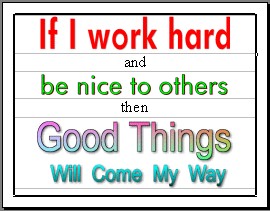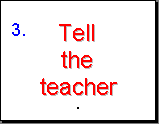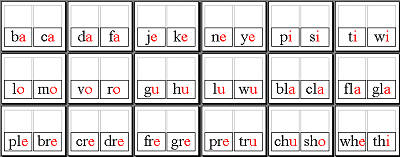|
Files
1 and 2 in our Grade One Reading Vocabulary Program
The
Classroom Reading Wall
Designed to run alongside
your current reading program
A
common sense - easy to use method for classroom teachers
to insure students
maintain solid reading vocabulary progress
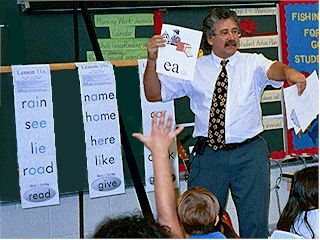 Our
Grade 1 Vocabulary Program lists all 340 first grade reading words on
two types of Reading Walls. The large "Classroom Reading Wall"
(right) is used by classroom teachers for introducing the day's new
words to the entire class (standing on chair optional...). Also
included is the "Student Reading Wall" (below) used for one-on-one
practice with a student to quickly pull up reading ability in lower
performing students. The large letters of the Classroom Reading Wall can
be seen 30 - 50 feet across the room so every
student can keep an eye on the action. If you would like to
read the unique teaching procedures behind the Classroom Reading Wall's
success - then download our Classroom Reading Wall Introduction in
either Word97
format or Acrobat
Reader 4.0. If you need a free viewer for either of these - go
to our Viewer Page.
This single sheet will explain the details and "magic" behind
the Classroom Reading Wall and how you can easily incorporate it into
your daily reading activities. You can also download a sample of
the Classroom Reading Wall by clicking Word97
format or Acrobat
Reader 4.0. Our
Grade 1 Vocabulary Program lists all 340 first grade reading words on
two types of Reading Walls. The large "Classroom Reading Wall"
(right) is used by classroom teachers for introducing the day's new
words to the entire class (standing on chair optional...). Also
included is the "Student Reading Wall" (below) used for one-on-one
practice with a student to quickly pull up reading ability in lower
performing students. The large letters of the Classroom Reading Wall can
be seen 30 - 50 feet across the room so every
student can keep an eye on the action. If you would like to
read the unique teaching procedures behind the Classroom Reading Wall's
success - then download our Classroom Reading Wall Introduction in
either Word97
format or Acrobat
Reader 4.0. If you need a free viewer for either of these - go
to our Viewer Page.
This single sheet will explain the details and "magic" behind
the Classroom Reading Wall and how you can easily incorporate it into
your daily reading activities. You can also download a sample of
the Classroom Reading Wall by clicking Word97
format or Acrobat
Reader 4.0.
The
Student Reading Wall
A wonderful
tool for home school parents and teachers for
quickly improving reading ability
in students who are
reading below Grade Level or who are
unable to maintain progress with the above Classroom Reading Wall.
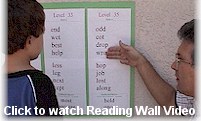 While
most students can easily maintain the pace of mastering the 10 words per
week using the Classroom Reading Wall techniques and support activities, there are still some
students who have difficulty maintaining this pace because of varying
degrees of learning difficulties. While other reading programs have
no "back-up" strategy to support students who are falling
behind - our TampaRead's Program contains a tremendously effective tool
for quickly bringing up reading skills in these students or in any
student reading one - two - or three or more years below Grade
Level. It is called the "Student Reading Wall" and is so
easy to implement that it can be done after 5 minutes of instruction
with a teacher assistant, volunteer or even a 4th or 5th grade
student helper !! The "Student Reading Wall"
contains the same words as the "Classroom Reading Wall" list,
but is 50% smaller. Follow the simple four step procedure
outlined below and any teacher or parent will begin advancing a child's
reading level at a truly impressive pace. If
you would like to observe the "Student Reading Wall" in action
- click the link below to begin a one minute video of 5 year old
Ryan saying the upper level Grade 1 Vocabulary words. While
most students can easily maintain the pace of mastering the 10 words per
week using the Classroom Reading Wall techniques and support activities, there are still some
students who have difficulty maintaining this pace because of varying
degrees of learning difficulties. While other reading programs have
no "back-up" strategy to support students who are falling
behind - our TampaRead's Program contains a tremendously effective tool
for quickly bringing up reading skills in these students or in any
student reading one - two - or three or more years below Grade
Level. It is called the "Student Reading Wall" and is so
easy to implement that it can be done after 5 minutes of instruction
with a teacher assistant, volunteer or even a 4th or 5th grade
student helper !! The "Student Reading Wall"
contains the same words as the "Classroom Reading Wall" list,
but is 50% smaller. Follow the simple four step procedure
outlined below and any teacher or parent will begin advancing a child's
reading level at a truly impressive pace. If
you would like to observe the "Student Reading Wall" in action
- click the link below to begin a one minute video of 5 year old
Ryan saying the upper level Grade 1 Vocabulary words.
View Reading Wall Video
If you are unable to view the video
above after 30 seconds,
you will probably need to download the free RealPlayer.
Click
here and scroll to the
bottom of their page to receive the "free" version of Real
Player.
THE
STUDENT READING WALL PROGRAM
TAPS INTO HOW THE BRAIN LEARNS EFFICIENTLY
Below are
the 4 steps to use with your student
when practicing the Student Reading Wall.
STEP 1
-
Say the colored vowel sound only
STEP 2 - Say "up to" the colored vowel sound
STEP 3 - Say the word slowly
STEP 4 - Begin "Timing" the student on reading the column
STEP
1 - SAY VOWEL SOUND - First, we need to make sure
the child can quickly say the vowel sound in each word. Starting
at the top - the child says the sound made only by the colored vowel
sound in each word. For example, in Lesson 36 which I practiced
with Ryan in the above picture and video, the list words were -
odd - cot - drop - wrong - hop - job - lost - along. I
begin by simply pointing to the red "o" in the word
"odd" and say the short o sound. I then
point to the red "o" in the next word "cot" and say
the short o sound. I do this for all the words and then have the
student say the sound as I point to each red letter. The repetition teaching
sequence of STEP 1 is now complete.
STEP
2 - SAY UP TO THE VOWEL SOUND - Next, we need to make
sure the child is decoding (sounding-out) the word in the correct
order. We do not have the child read the whole word in this step
yet,
but only say the sound of the letters up to the colored vowel sound (o
(short o) - co - dro - wro - ho - etc). This teaches the child the
strategy we want them to use when trying to figure out all unknown
words. It is called "STOP AT THE VOWEL SOUND" and simply
means for the child to move their eyes across a word up to the vowel
sound and say only those sounds first. This is a simple consistent
process that makes sense to the child and is easy for the child to
implement.
STEP
3 - READ THE COMPLETE WORD
Now that the first two steps have been practiced and the sounds are
in the child's short term memory - it's time to try to read the
entire word. Before beginning, we remind the child to use the STEP
2 "STOP AT THE VOWEL SOUND" trick but to now add the
last sound(s) to say the entire word.
Let me emphasize here that
whenever the child makes a mistake when saying the word (which will usually happen
the first couple times of attempting the list) you must stop them immediately and make them
look directly at the place in the word where they made a mistake. For example, if the word
was "hop" and the child said "hot"
- you would jump in and say something like - "NO - hold on a
second - "What sound does the "p" make at the end of this
word?" The child says - "puh...." and
you would say - "Well if p says puh...... - what is the word?
The
child says "hop" and you say - "GOOD - let's
try all the words again." It is very important you do
not tell the child the correct word immediately when they make a
mistake. You must guide them to use their newly found phonics skills
to decode the word properly. When the child can say all words in the column without any mistakes
- we move to STEP 4.
STEP 4
- BEGIN THE "TIMED" READING PROCESS
Get out the stop watch.... Now comes the most important
part of the strategy which gives the practice needed for complete
memorization and also adds the
motivation which keeps the children asking - "When can I do the
Reading Wall?"
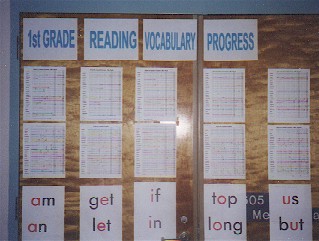 Just
like in step 3 we have the child read the column words from top to
bottom, only this time we use a stop watch (or timer on your watch) and
say "ON YOUR MARK GET SET - GO !!!" Just
like in step 3 we have the child read the column words from top to
bottom, only this time we use a stop watch (or timer on your watch) and
say "ON YOUR MARK GET SET - GO !!!"
The charts above the column words
(seen in the right photograph) were used to record the times of about 30
children who were reading below level from four different 1st grade
classes. For example, if
it takes a child 25 seconds to say the column of words - use a colored
crayon and fill it up to the 25 second mark on the horizontal bar
graph. It's that
simple. On the next attempt, if it takes the child 20
seconds to say the column - you fill in up to 20 seconds on the
chart. The child immediately sees the progress he/she made - gives
you a big smile and quickly says - "Let's try it again.."
and again...
LOOK! - I
BEAT THE LIST
When the child can say the list in 10
seconds they have reached the mastery time and can proceed to the next
column Level. However, I do not write down their 10 second
"winning" time until they say the list backwards (from bottom to
top - but are not timed.) This helps set the words a little deeper
in the child's long term memory and makes sure there was no auditory
memorizing of word order.
The bottom line...... You'll be
thoroughly impressed at how quickly these unique four sequential steps
will enable practically any child to become a highly successful
reader.
Typical
timed scores for saying all words in a column for
1st Grade children of different abilities are as follows:
SAYING READING
WALL COLUMN |
Above
Average |
Average |
Below
Average |
Learning
Disability |
| 1st ATTEMPT |
18 seconds |
25 seconds |
40 seconds |
50 seconds |
| 2nd ATTEMPT |
12 seconds |
20 seconds |
30 seconds |
45 seconds |
| 3rd ATTEMPT |
8 - 10 seconds |
15 seconds |
25 seconds |
40 seconds |
| 4th ATTEMPT |
|
12 seconds |
20 seconds |
35 seconds |
| 5th ATTEMPT |
|
10 seconds |
15 seconds |
30 seconds |
| 6th ATTEMPT |
|
|
12 seconds |
27 seconds |
| 7th ATTEMPT |
|
|
10 seconds |
24 seconds |
| 8th ATTEMPT |
|
|
|
21 seconds |
| 9th ATTEMPT |
|
|
|
18 seconds |
| 10th ATTEMPT |
|
|
|
15 seconds |
But does
this teach a child to read?
For the whole language advocates who
question this type of vocabulary word teaching I hope they will take the
time to read the latest research from the National Institutes of Health
available from our Phonics Research link on our home page. To restate
one of their findings:
"Vocabulary
+ Fluency = Comprehension"
The entire set of Grade One
Reading Wall columns were set up along the main hallway of the 1st grade
classes at our school in Tampa, Florida. After completing the
major reading activities in the morning, I would bring children out to
the hall to practice on the Reading Wall. The level of enthusiasm
each child displayed in being able to come into the hall to practice
beating their previous time was remarkable.
Teacher Strategies:
To achieve maximum benefit from this strategy - 1st Grade teachers
should place the Classroom Reading Wall column in front of their classroom for one week
at a time beginning the second month of school (the first month you need
to review basic letters and sounds ). Following this schedule of
one "Column Level" per week you will not overload the children
and will be right on target for having appropriate reading vocabulary
for the standardized tests come spring. Our writing worksheets and
vocabulary building exercises also parallel the same words in the
Reading Wall columns so you're all set with additional support
activities.
Parent Strategies:
Parents should place 3-5 of the Student Reading Wall columns side by side
on a wall in your home (child's room - kitchen corner - etc.)
Spend 2-3 minutes several times a day (that's all it takes) and your child's progress
will increase tremendously.
|
 The
14 files below will insure your child's reading ability is in the top 10%
of his/her 1st Grade class. Use alongside any current reading
program or by itself to achieve mastery of essential phonics -
vocabulary and Grade 1 reading skills. When used for only 20-30 minutes per day, you'll notice a dramatic improvement in
how fast your student(s) master new reading words on a weekly basis. If you have any
questions about the TampaReads/ReadingKey program or difficulty with downloading,
contact us
directly at the email or phone number below.
The
14 files below will insure your child's reading ability is in the top 10%
of his/her 1st Grade class. Use alongside any current reading
program or by itself to achieve mastery of essential phonics -
vocabulary and Grade 1 reading skills. When used for only 20-30 minutes per day, you'll notice a dramatic improvement in
how fast your student(s) master new reading words on a weekly basis. If you have any
questions about the TampaReads/ReadingKey program or difficulty with downloading,
contact us
directly at the email or phone number below. Our
Grade 1 Vocabulary Program lists all 340 first grade reading words on
two types of Reading Walls. The large "Classroom Reading Wall"
(right) is used by classroom teachers for introducing the day's new
words to the entire class (standing on chair optional...). Also
included is the "Student Reading Wall" (below) used for one-on-one
practice with a student to quickly pull up reading ability in lower
performing students. The large letters of the Classroom Reading Wall can
be seen 30 - 50 feet across the room so every
student can keep an eye on the action. If you would like to
read the unique teaching procedures behind the Classroom Reading Wall's
success - then download our Classroom Reading Wall Introduction in
either
Our
Grade 1 Vocabulary Program lists all 340 first grade reading words on
two types of Reading Walls. The large "Classroom Reading Wall"
(right) is used by classroom teachers for introducing the day's new
words to the entire class (standing on chair optional...). Also
included is the "Student Reading Wall" (below) used for one-on-one
practice with a student to quickly pull up reading ability in lower
performing students. The large letters of the Classroom Reading Wall can
be seen 30 - 50 feet across the room so every
student can keep an eye on the action. If you would like to
read the unique teaching procedures behind the Classroom Reading Wall's
success - then download our Classroom Reading Wall Introduction in
either 
 Just
like in step 3 we have the child read the column words from top to
bottom, only this time we use a stop watch (or timer on your watch) and
say "ON YOUR MARK GET SET - GO !!!"
Just
like in step 3 we have the child read the column words from top to
bottom, only this time we use a stop watch (or timer on your watch) and
say "ON YOUR MARK GET SET - GO !!!"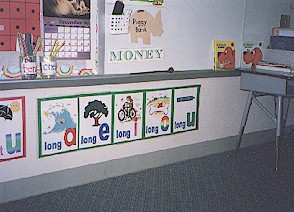





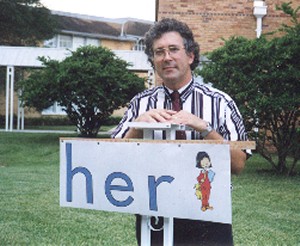


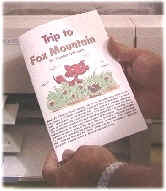 Here's
a first for the Internet. This is a complete 12 page book which
you a can print out and make at home (or print extra copies for an
entire reading group!). Takes only a few minutes.
Here's
a first for the Internet. This is a complete 12 page book which
you a can print out and make at home (or print extra copies for an
entire reading group!). Takes only a few minutes. 